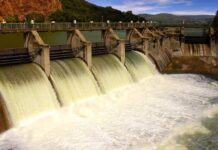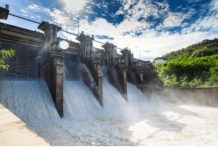The project is located 450km south west of Dar Es Salaam and 80km south of Iringa. The concrete gravity dam on the Kihansi River has a height of 25m and a length of 200m, which creates a reservoir with a storage volume of 1 million m³. The turbines use the 900m drop in the Kihansi Gorge over a distance of about 3km, and return the water to the river about 6km downstream. When the reservoir is full, the inundation is about 26ha.
The project cost $275 million in total, financed by TANESCO/Tanzania Government, World Bank/IDA, NORAD, SIDA, KfW and the EIB.
IMPREGLIO SpA was hired to construct the main civil works for the Lower Kihansi Hydropower project. The main engineers on the project, which began in July 1995, included Norplan A/S in association with Norconsult and IVO International.
HYDROPOWER PROJECT MAKE-UP
The plant has a drop shaft and headrace tunnel, ending with three embedded steel penstocks. An underground power station cavern was constructed with an initial installed capacity of 180MW in three units, and a potential ultimate installation of 300MW in five units.
In addition, there is a 2,200m-long restitution tunnel, a 1,500m-long tailrace tunnel, a 130m-long tailrace culvert and an 800m-long tailrace canal. IMPREGLIO was also responsible for constructing a 1,070m-long access tunnel to the power station and a permanent access and service road of around 16km in length.
CONCRETE GRAVITY DAM
The middle section of the dam is a 70m-long concrete free overflow spillway with no flood discharge regulation gates. The design discharge capacity of the dam is 470m³/s. A 6m x 3m radial gate at a lower level in the dam flushes sediment silt from the reservoir, and a 2m x 2m sliding gate flushes silt deposited at the bottom of the intake.
The intake to the power plant forms an integral part of the dam structure located on the left side of the river. The intake construction consists of a trash rack of 10m x 6m, arrangements for stop logs and a 4m x 5m intake roller gate. The dam is founded on hard rock, except for the outer part of the dam abutments, which were founded on softer rock.
A cement grout curtain wall was bored under the length of the dam foundations. Downstream of the spillway slopes erosion protection works consist of concrete retaining walls and riprap works.
STEEL LINED HEADRACE TUNNEL
The tunnelling system has a 25m² cross section vertical shaft that is 404m long and on a 1:7 slope as well as a 30m² cross section headrace tunnel that is 2,280m in length. The steel-lined part of the headrace tunnel starts 120m ahead of the power station. A stone trap was constructed just before starting the steel-lined section to take care of any stones being washed through the tunnel. The 40m² cross section access tunnel to the power station is 1,070m long, with an additional 110m tunnel to the transformer galleries. Two transport tunnels were erected in the power station area, one as access to the stone trap and one as access to the tailrace tunnel, which is 1,500m long with a cross section of 34m².
The tailrace canal is 800m long. The first 130m consist of a concrete culvert built within steel sheet piles and completed with backfilling. The next 650m were excavated in sections where the soft soil (silt) excavated under water was replaced by rockfill taken from the tunnel spoil heal. Geotextile was placed against the silt before the rock was filled in.
The switchyard area, landscaping and environmental works were also included in the contract. A 16km permanent access and service road was also constructed.
CONTINUING ENVIRONMENTAL CONCERNS
Tanzania has an electricity per capita consumption of about 64kWh/y (compared with over 10,000kWh/y for developed and 900kWh/y for emerging countries like India and China). The Tanzanian power system generates 65% of the country’s total 860MW capacity from hydropower, and the Lower Kihansi hydroelectric dam generates 180MW of this total with no CO2 emissions.
Evidence of environmental damage during the dam’s construction led to NORAD (one of the financers) making its own technical review. It found the original World Bank environmental assessment to be of such poor quality that it financed its own Environmental Impact Assessment (EIA). The dam had destroyed an 800m-high waterfall, affected over 20,000 villagers, and developed a protected natural area with several species of rare plants and a species of toad (Nectophrynoides asperginis) that was new to science.
A short-term emergency project tried to recreate the spray zone conditions and an artificial sprinkler seems to have stabilized the toad population. Final water rights have been delayed because of a dispute over the dam’s continuous release of 7m³/s into the ecosystem.
TANESCO OPERATES PLANT
The Tanzania Electric Supply Company (TANESCO), the privatized Tanzanian electricity supply company, operates the plant for the Government of Tanzania.
i














































